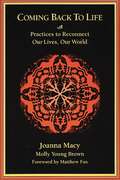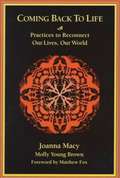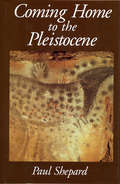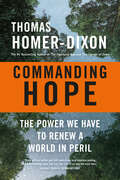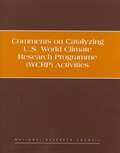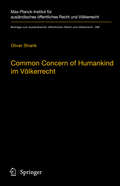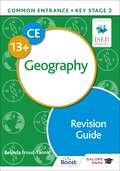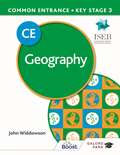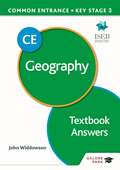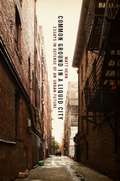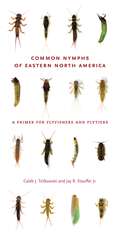- Table View
- List View
Coming Back to Life
by Joanna R. Macy Molly Young BrownMany of us feel called to respond to the ecological destruction of our planet, yet we feel overwhelmed, immobilized, and unable to deal realistically with the threats to life on Earth. Noted spiritual and environmental thinkers Joanna Macy and Molly Young Brown contend that this crippling response to world crisis is a psychological defense mechanism that has been endemic since the years of the Cold War arms race, when we had to adapt within a single generation to the horrific possibility of nuclear holocaust.Since its publication in 1983, Joanna Macy's book, Despair and Personal Power in the Nuclear Age has sold nearly 30,000 copies and has been the primary resource for groups of men and women confronting the challenging realities of our time without succumbing to paralysis or panic. Coming Back to Life provides a much needed update and expansion of this pioneering work. At the interface between spiritual breakthrough and social action, Coming Back to Life is eloquent and compelling as well as being an inspiring and practical guide. The first third of the book discusses with extraordinary insight the angst of our era, and the pain, fear, guilt and inaction it has engendered; it then points forward to the way out of apathy, tio "the work that reconnects". The rest of the book offers both personal counsel and easy-to-use methods for working with groups in a number of ways to profoundly affect peoples' outlook and ability to act in the world.Table of ContentsForeword by Mathew Fox1. To Choose Life2. The Greatest Danger: Apatheia, The Deadening of Mind & Heart3. The Basic Miracle: Our True Nature & Power4. The Work that Reconnects5. Guiding Group Work6. Affirmation: Coming from Gratitude7. Despair Work: Owning & Honoring Our Pain for the World8. The Shift: Seeing with New Eyes9. Deep Time: Drawing on Past & Future Generations10. The Council of All Beings: Rejoining the Natural World11. Going Forth12. Meditations for Coming Back to LifeJoanna Macy has developed an international following over the course of 40 years as a speaker and workshop leader on Buddhist philosophy and the deep ecology movement
Coming Back to Life: Practices to Reconnect Our Lives, Our World
by Joanna R. Macy Molly Young BrownMany of us feel called to respond to the ecological destruction of our planet, yet we feel overwhelmed, immobilized, and unable to deal realistically with the threats to life on Earth. Noted spiritual and environmental thinkers Joanna Macy and Molly Young Brown contend that this crippling response to world crisis is a psychological defense mechanism that has been endemic since the years of the Cold War arms race, when we had to adapt within a single generation to the horrific possibility of nuclear holocaust. Since its publication in 1983, Joanna Macy's book, Despair and Personal Power in the Nuclear Age has sold nearly 30,000 copies and has been the primary resource for groups of men and women confronting the challenging realities of our time without succumbing to paralysis or panic. Coming Back to Life provides a much needed update and expansion of this pioneering work. At the interface between spiritual breakthrough and social action, Coming Back to Life is eloquent and compelling as well as being an inspiring and practical guide. The first third of the book discusses with extraordinary insight the angst of our era, and the pain, fear, guilt and inaction it has engendered; it then points forward to the way out of apathy, tio "the work that reconnects". The rest of the book offers both personal counsel and easy-to-use methods for working with groups in a number of ways to profoundly affect peoples' outlook and ability to act in the world.
Coming Back to Life: The Updated Guide to The Work that Reconnects
by Matthew Fox Molly Young Brown Joanna MacyDeepening global crises surround us. We are beset by climate change, fracking, tar sands extraction, GMOs, and mass extinctions of species, to say nothing of nuclear weapons proliferation and Fukushima, the worst nuclear disaster in history. Many of us fall prey to despair even as we feel called to respond to these threats to life on our planet.Authors Joanna Macy and Molly Brown address the anguish experienced by those who would confront the harsh realities of our time. In this fully updated edition of Coming Back to Life, they show how grief, anger, and fear are healthy responses to threats to life, and when honored can free us from paralysis or panic, through the revolutionary practice of the Work that Reconnects. New chapters address working within the corporate world, and engaging communities of color as well as youth in the Work.The Work that Reconnects has spread around the world, inspiring hundreds of thousands to work toward a life-sustaining human culture. Coming Back to Life introduces the Work's theoretical foundations, illuminating the angst of our era with extraordinary insight. Pointing the way forward out of apathy, it offers personal counsel as well as easy-to-use methods for group work that profoundly affect peoples' outlook and ability to act in the world.Joanna Macy is a scholar, eco-philosopher, teacher, activist, and author of twelve previous books including Coming Back to Life.Molly Young Brown is a teacher, trainer, counselor, and author of four previous books on psychology and Earth-based spirituality.
Coming Home to the Pleistocene
by Paul Shepard Florence R. ShepardPaul Shepard was one of the most profound and original thinkers of our time. Seminal works like The Tender Carnivore and the Sacred Game, Thinking Animals, and Nature and Madness introduced readers to new and provocative ideas about humanity and its relationship to the natural world. Throughout his long and distinguished career, Paul Shepard returned repeatedly to his guiding theme, the central tenet of his thought: that our essential human nature is a product of our genetic heritage, formed through thousands of years of evolution during the Pleistocene epoch, and that the current subversion of that Pleistocene heritage lies at the heart of today's ecological and social ills.Coming Home to the Pleistocene provides the fullest explanation of that theme. Completed just before his death in the summer of 1996, it represents the culmination of Paul Shepard's life work and constitutes the clearest, most accessible expression of his ideas. Coming Home to the Pleistocene pulls together the threads of his vision, considers new research and thinking that expands his own ideas, and integrates material within a new matrix of scientific thought that both enriches his original insights and allows them to be considered in a broader context of current intellectual controversies. In addition, the book explicitly addresses the fundamental question raised by Paul Shepard's work: What can we do to recreate a life more in tune with our genetic roots? In this book, Paul Shepard presents concrete suggestions for fostering the kinds of ecological settings and cultural practices that are optimal for human health and well-being.Coming Home to the Pleistocene is a valuable book for those familiar with the life and work of Paul Shepard, as well as for new readers seeking an accessible introduction to and overview of his thought.
Coming of Age at the End of Nature: A Generation Faces Living on a Changed Planet
by Julie Dunlap Susan A. CohenComing of Age at the End of Nature explores a new kind of environmental writing. This powerful anthology gathers the passionate voices of young writers who have grown up in an environmentally damaged and compromised world. Each contributor has come of age since Bill McKibben foretold the doom of humanity's ancient relationship with a pristine earth in his prescient 1988 warning of climate change, The End of Nature.What happens to individuals and societies when their most fundamental cultural, historical, and ecological bonds weaken-or snap? In Coming of Age at the End of Nature, insightful millennials express their anger and love, dreams and fears, and sources of resilience for living and thriving on our shifting planet.Twenty-two essays explore wide-ranging themes that are paramount to young generations but that resonate with everyone, including redefining materialism and environmental justice, assessing the risk and promise of technology, and celebrating place anywhere from a wild Atlantic island to the Arizona desert, to Baltimore and Bangkok. The contributors speak with authority on problems facing us all, whether railing against the errors of past generations, reveling in their own adaptability, or insisting on a collective responsibility to do better.
Command Companion of Seamanship Techniques
by David HouseThe Command Companion of Seamanship Techniques is the latest work from the well-respected marine author, D J House. It contains all the information needed for command posts at sea.· All aspects of shipboard management are discussed, with special emphasis placed on health and safety.· Guidelines on how to respond to accidents and emergencies at sea· Contains the most recent SOLAS revisions and a discussion of marine law to keep you up to date with the latest rules and regulations.In order to aid learning, the book includes a number of worked examples in the text along with questions and answers at the end of chapters. The author tells you how to respond to accidents and emergencies at sea, in the event, for example of cargo contamination, collision, loss of stability due to cargo shift and damage due to flooding, fire plus loss of life/crew. In addition, the SOLAS revisions and a discussion of marine law is included to keep you up to date with all the latest rules and regulations.In order to aid learning, this book will include a number of worked examples in the text along with questions and answers at the end of chapters.D J House is senior lecturer in Nautical studies at the Nautical college, Fleetwood. His sea-going experience includes general cargo, reefer, bulk cargo, passenger and liner trades, underwater operations, and roll-on/roll-off ferries. He is a well-known marine author and has written Seamanship Techniques Volumes 1 and 2 (combined) and he has revised Cargo Work in the Kemp & Young series.
Commanding Hope: The Power We Have to Renew a World in Peril
by Thomas Homer-DixonFrom the #1 BESTSELLING thought leader: Calling on history, cutting-edge research, complexity science and even Lord of the Rings, Thomas Homer-Dixon lays out the tools we can command to rescue a world on the brink.For three decades, the renowned author of The Upside of Down: Catastrophe, Creativity, and the Renewal of Civilization, and The Ingenuity Gap: Can We Solve the Problems of the Future?, has examined the threats to our future security--predicting a deteriorating global environment, extreme economic stresses, mass migrations, social instability and wide political violence if humankind continued on its current course. He was called The Doom Meister, but we now see how prescient he was. Today just about everything we've known and relied on (our natural environment, economy, societies, cultures and institutions) is changing dramatically--too often for the worse. Without radical new approaches, our planet will become unrecognizable as well as poorer, more violent, more authoritarian.In his fascinating long-awaited new book (dedicated to his young children), he calls on his extraordinary knowledge of complexity science, of how societies work and can evolve, and of our capacity to handle threats, to show that we can shift human civilization onto a decisively new path if we mobilize our minds, spirits, imaginations and collective values. Commanding Hope marshals a fascinating, accessible argument for reinvigorating our cognitive strengths and belief systems to affect urgent systemic change, strengthen our economies and cultures, and renew our hope in a positive future for everyone on Earth.
Commemorative Spaces of the First World War: Historical Geographies at the Centenary (Routledge Research in Historical Geography)
by James Wallis David C. HarveyThis is the first book to bring together an interdisciplinary, theoretically engaged and global perspective on the First World War through the lens of historical and cultural geography. Reflecting the centennial interest in the conflict, the collection explores the relationships between warfare and space, and pays particular attention to how commemoration is connected to spatial elements of national identity, and processes of heritage and belonging. Venturing beyond military history and memory studies, contributors explore conceptual contributions of geography to analyse the First World War, as well as reflecting upon the imperative for an academic discussion on the War’s centenary. This book explores the War’s impact in more unexpected theatres, blurring the boundary between home and fighting fronts, investigating the experiences of the war amongst civilians and often overlooked combatants. It also critically examines the politics of hindsight in the post-war period, and offers an historical geographical account of how the First World War has been memorialised within ‘official’ spaces, in addition to those overlooked and often undervalued ‘alternative spaces’ of commemoration. This innovative and timely text will be key reading for students and scholars of the First World War, and more broadly in historical and cultural geography, social and cultural history, European history, Heritage Studies, military history and memory studies.
Comments on Catalyzing U.S. World Climate Research Programme (WCRP) Activities
by Climate Research CommitteeThe National Academies Press (NAP)--publisher for the National Academies--publishes more than 200 books a year offering the most authoritative views, definitive information, and groundbreaking recommendations on a wide range of topics in science, engineering, and health. Our books are unique in that they are authored by the nation's leading experts in every scientific field.
Common Concern of Humankind im Völkerrecht (Beiträge zum ausländischen öffentlichen Recht und Völkerrecht #289)
by Oliver StrankDieses Buch untersucht die philosophischen Grundlagen und die geschichtliche Entwicklung des common concern of humankind-Begriffs und seine Rechtswirkungen im Völkerrecht. Hierbei wird das Prinzip in den Bestand des Umweltvölkerrechts eingeordnet und sein Verhältnis zum Grundsatz der Staatensouveränität untersucht. Außerdem wird das common concern-Prinzip vom common heritage-Prinzip abgegrenzt und völkerrechtstheoretisch dargelegt, welche Wirkung es als Prinzip innerhalb und außerhalb der von ihm erfassten Regime entfaltet. Der Autor begründet, dass mit der Verankerung des common concern of humankind-Prinzips in der Klimarahmenkonvention und im Pariser Abkommen sowie in der Biodiversitätskonvention die dort enthaltenen Umweltschutzpflichten zu solchen gegenüber der Staatengemeinschaft als Ganzes geworden sind, sodass sich alle Vertragsstaaten - unabhängig von einer eigenen Betroffenheit - gegenüber allen anderen Vertragsstaaten auf ihre Erfüllung berufen können und eine Klagebefugnis vor dem Internationalen Gerichtshof haben.
Common Entrance 13+ Geography Exam Practice Questions and Answers
by Belinda Froud-YannicExam board: ISEB Level: 13+ CE and KS3 Subject: Geography First exam: November 2022Help pupils feel fully prepared for their CE 13+ Geography exams with this extensive ISEB-endorsed exam practice book, aligned to the latest ISEB specification.· Boost confidence with ISEB exam-style questions: practise with a wealth of questions arranged by topic covering all areas of the specification.· Hone exam technique: familiarise pupils with the format and style of questions in the new exam.· Easily mark practice questions: answer guidance has been designed to be clear and easy-to-follow for teachers, parents or tutors marking practice questions, in line with the ISEB mark scheme.· Improve exam results: includes model answers with advice and guidance for achieving top marks.Cover all the topics and skills required for the exam with the Common Entrance 13+ Geography Revision Guide (ISBN: 9781398349674).
Common Entrance 13+ Geography Exam Practice Questions and Answers
by Belinda Froud-YannicExam board: ISEB Level: 13+ CE and KS3 Subject: Geography First exam: November 2022Help pupils feel fully prepared for their CE 13+ Geography exams with this extensive ISEB-endorsed exam practice book, aligned to the latest ISEB specification.· Boost confidence with ISEB exam-style questions: practise with a wealth of questions arranged by topic covering all areas of the specification.· Hone exam technique: familiarise pupils with the format and style of questions in the new exam.· Easily mark practice questions: answer guidance has been designed to be clear and easy-to-follow for teachers, parents or tutors marking practice questions, in line with the ISEB mark scheme.· Improve exam results: includes model answers with advice and guidance for achieving top marks.Cover all the topics and skills required for the exam with the Common Entrance 13+ Geography Revision Guide (ISBN: 9781398349674).
Common Entrance 13+ Geography Revision Guide
by Belinda Froud-YannicExam board: ISEB Level: 13+ CE and KS3 Subject: Geography First exam: November 2022Equip your pupils with the skills and confidence they need to excel in their 13+ CE Geography exams with this comprehensive ISEB-endorsed revision guide.· Revise all topics in the new specification: the guide covers all topics in the new ISEB specification in depth, including a new focus on the environment.· Clear illustrations with engaging visuals: well-annotated illustrations, photos, maps and charts aid learning and recall.· Build confidence ahead of the exam: hone technique with practice of ISEB exam-style questions, with tips and advice along the way.Practise with even more exam-style questions with Common Entrance 13+ Geography Exam Practice Questions and Answers (ISBN: 9781398322103).
Common Entrance 13+ Geography Revision Guide
by Belinda Froud-YannicExam board: ISEB Level: 13+ CE and KS3 Subject: Geography First exam: November 2022Equip your pupils with the skills and confidence they need to excel in their 13+ CE Geography exams with this comprehensive ISEB-endorsed revision guide.· Revise all topics in the new specification: the guide covers all topics in the new ISEB specification in depth, including a new focus on the environment.· Clear illustrations with engaging visuals: well-annotated illustrations, photos, maps and charts aid learning and recall.· Build confidence ahead of the exam: hone technique with practice of ISEB exam-style questions, with tips and advice along the way.Practise with even more exam-style questions with Common Entrance 13+ Geography Exam Practice Questions and Answers (ISBN: 9781398322103).
Common Entrance 13+ Geography for ISEB CE and KS3
by John WiddowsonExam board: ISEB Level: 13+ CE and KS3 Subject: Geography First teaching: September 2021 First exams: November 2022Trust John Widdowson and his extensive experience in Common Entrance to guide you through the new ISEB 13+ CE Geography specification so you can help your pupils build confidence, proficiency and a love of Geography with the new Geography series for Common Entrance at 13+ and Key Stage 3.- Support new specification content on the issues tomorrow's geographers will face: A new chapter on the environment looks at local, national and global issues, focusing on sustainability and stewardship (a new addition to the 13+ CE specification for first examination from November 2022).- Push your pupils to achieve the best results: The new 'Your challenge' feature offers additional tasks to stretch pupils.- Cover all the content for human and physical Geography in one book: A more convenient and cost-effective approach for teachers and pupils. - Develop your pupils' investigative skills: An enquiry-based approach encourages pupils to develop their investigative skills.- Guide your pupils to think and work like geographers: The emphasis on geographical skills such as map reading and using sources and resources (for example, interpreting graphs, photos and maps) helps your pupils apply their knowledge.- Beautifully illustrated with engaging visuals: Packed with clear photos, maps and charts to aid learning and recall. Accompanying answers available as a paid-for PDF download at galorepark.co.uk (ISBN: 9781398322127).
Common Entrance 13+ Geography for ISEB CE and KS3
by John WiddowsonExam board: ISEB Level: 13+ CE and KS3 Subject: Geography First teaching: September 2021 First exams: November 2022Trust John Widdowson and his extensive experience in Common Entrance to guide you through the new ISEB 13+ CE Geography specification so you can help your pupils build confidence, proficiency and a love of Geography with the new Geography series for Common Entrance at 13+ and Key Stage 3.· Support new specification content on the issues tomorrow's geographers will face: A new chapter on the environment looks at local, national and global issues, focusing on sustainability and stewardship (a new addition to the 13+ CE specification).· Motivate your pupils to excel: The new 'Your Challenge' feature offers additional tasks for high achieving pupils.· Cover all the content for human and physical Geography in one book: A more convenient and cost-effective approach for teachers and pupils.· Develop your pupils' investigative skills: An enquiry-based approach encourages pupils to develop these key skills.· Guide your pupils to think and work like geographers: The emphasis on enquiry and geographical skills such as map reading will help take your pupils to the next level.· Beautifully illustrated with engaging visuals: Packed with clear photos, maps and charts to aid learning and recall.Accompanying answers available as a paid-for PDF download at galorepark.co.uk (ISBN: 9781398322127).
Common Entrance 13+ Geography for ISEB CE and KS3 Textbook Answers
by John WiddowsonThis PDF download contains full answers to all questions in Common Entrance 13+ Geography for ISEB CE and KS3 (ISBN: 9781398322073).· Answers and indicative content.· Clear layout saves time marking work and allows you to efficiently assess pupils' strengths and weaknesses.· A sample Scheme of Work presents the CE content which must be covered in preparation for CE 13+. It is possible to deliver the content in a number of different ways and we present an option that can be followed or adapted.As a downloadable PDF, please note this resource is non-refundable.
Common Entrance 13+ Geography for ISEB CE and KS3 Textbook Answers
by John WiddowsonThis resource contains full answers to all questions in Common Entrance 13+ Geography for ISEB CE and KS3 (ISBN: 9781398322073).· Answers and indicative content.· Clear layout saves time marking work and allows you to efficiently assess pupils' strengths and weaknesses.· A sample Scheme of Work presents the CE content which must be covered in preparation for CE 13+. It is possible to deliver the content in a number of different ways and we present an option that can be followed or adapted.Please note this resource is non-refundable.
Common Ground in a Liquid City
by Matt HernIf we want to preserve what's still left of the natural world, we need to stop using so much of it. And, says veteran environmental activist Matt Hern, cities are the best chance we have left for a truly ecological future . . . but what does it take to make a truly sustainable city?Common Ground in a Liquid City is a fun and engaging look at the future of urban life. Hern takes us on a journey through over a dozen urban centers, from Vancouver to Istanbul, Las Vegas, and beyond, exploring the history and current composition of cities around the globe and highlighting the elements of each that make it livable.Each of Hern's ten chapters focuses on a central theme of city life: diversity, street life, crime, population density, water and natural life, gentrification, and globalism. What emerges in the end is an appealing portrait of what the urban future might look like--environmentally friendly, locally focused, and governed from below.Matt Hern is an inveterate city dweller and an environmental and education activist. The editor of Everywhere All the Time: A New Deschooling Reader and the author of Deschooling Our Lives and Field Day, he founded Vancouver's Car-Free Day and is the director of the Purple Thistle Center for alternative education. These days, he lives in Vancouver with his partner and daughters and lectures widely around the globe.
Common Ground on Hostile Turf: Stories from an Environmental Mediator
by Lucy MooreIn our increasingly polarized society, there are constant calls for compromise, for coming together. For many, these are empty talking points--for Lucy Moore, they are a life's work. As an environmental mediator, she has spent the past quarter century resolving conflicts that appeared utterly intractable. Here, she shares the most compelling stories of her career, offering insight and inspiration to anyone caught in a seemingly hopeless dispute. Moore has worked on wide-ranging issues--from radioactive waste storage to loss of traditional grazing lands. More importantly, she has worked with diverse groups and individuals: ranchers, environmental activists, government agencies, corporations, tribal groups, and many more. After decades spent at the negotiating table, she has learned that a case does not turn on facts, legal merit, or moral superiority. It turns on people. Through ten memorable stories, she shows how issues of culture, personality, history, and power affect negotiations. And she illustrates that equitable solutions depend on a healthy group dynamic. Both the mediator and opposing parties must be honest, vulnerable, open, and respectful. Easier said than done, but Moore proves that subtle shifts can break the logjam and reconcile even the most fiercely warring factions. This book should be especially appealing to anyone concerned with environmental conflicts; and also to students in environmental studies, political science, and conflict resolution, and to academics and professionals in mediation and conflict resolution fields.
Common Ground: Encounters with Nature at the Edges of Life
by Rob CowenAll too often, we think of nature as something distinct from ourselves, something to go and see, a place that’s separate from the ordinary modern world in which we live and work. But if we take the time to look, we soon find that’s not how nature works. Even in our parceled-out, paved-over urban environs, nature is all around us; it is in us. It is us. That’s what Rob Cowen discovered after moving to a new home in northern England. After ten years in London he was suddenly adrift, searching for a sense of connection. He found himself drawn to a square-mile patch of waste ground at the edge of town. Scrappy, weed-filled, this heart-shaped tangle of land was the very definition of overlooked—a thoroughly in-between place that capitalism no longer had any use for, leaving nature to take its course. Wandering its meadows, woods, hedges, and fields, Cowen found it was also a magical, mysterious place, haunted and haunting, abandoned but wildly alive—and he fell in fascinated love. Common Ground is a true account of that place and Cowen’s transformative journey through its layers and lives, but it’s much more too. As the land’s stories intertwine with events in his own life—and he learns he is to become a father for the first time—the divisions between human and nature begin to blur and shift. The place turns out to be a mirror, revealing what we are, what we’re not and how those two things are ultimately inseparable. This is a book about discovering a new world, a forgotten world on the fringes of our daily lives, and the richness that comes from uncovering the stories and lives—animal and human—contained within. It is an unforgettable piece of nature writing, part of a brilliant tradition that stretches from Gilbert White to Robert Macfarlane and Helen Macdonald. “I am dreaming of the edge-land again,” Cowen writes. Read Common Ground, and you, too, will be dreaming of the spaces in between, and what—including us—thrives there.
Common Ground: How the Crisis of the Earth is Saving Us from Our Illusion of Separation
by Eileen FlanaganIn Common Ground, veteran organizer Eileen Flanagan weaves together a series of stories of hard won successes in the climate change movement, including against a multinational bank in one case, and a heavily polluting fossil fuel company in another, based on grassroots organizing.As heat waves, wildfires, storms, and floods become ever more deadly, the book describes a groundswell of action in which citizens of all ages, races and political stripes struggle to understand each other and the enormous challenges we face fighting companies and governments wilfully blind to the climate change dangers we face as a society.A Quaker activist, facilitator, and teacher, Flanagan takes us on a personal journey through her environmental direct-action experiences as well as her relationships with community leaders to understand how we can form coalitions to actually make a difference. Flanagan shows that &“the illusion of separation&”—the fallacy that humans can thrive in a dying world—is at the root of interlocking environmental crises and that it&’s often politicians and corporations who benefit by keeping the rest of us divided across lines of race, class, religion, and generation.In Common Ground, Flanagan argues that more than technology or even elections, acting in solidarity with all life is humanity&’s best hope for survival.Includes a foreword by internationally acclaimed South African activist Kumi Naidoo, President of the Fossil Fuel Non-Proliferation Treaty Initiative and former head of Greenpeace International and Amnesty International.
Common Ground: The Water, Earth And Air We Share
by Molly BangFrom the Caldecott Honor author Molly Bang, author-illustrator of the critically acclaimed Sunlight Series, this is a simple story of our planet's natural resources. Through the example of a shared village green and the growing needs of the townspeople who share it, Molly Bang presents the challenge of handling our planet's natural resources. With jewel-like paintings and simple text, Bang impresses upon us the urgency of conserving and preserving our earth's limited bounty.
Common Nymphs of Eastern North America: A Primer for Flyfishers and Flytiers (Keystone Books)
by Caleb J. Tzilkowski Jay R. Stauffer Jr.Although the concept of “matching the hatch” has been central to flyfishing for 150 years, it has been used almost exclusively for dry flyfishing. With Common Nymphs of Eastern North America: A Primer for Flyfishers and Flytiers, Caleb Tzilkowski and Jay Stauffer Jr. take trout enthusiasts in another hatch-matching direction—to the year-round underwater nymph “hatch,” which, in most cases, constitutes 90 percent of trout diets. Successful flyfishers have at least rudimentary knowledge of the organisms that artificial flies imitate. The relatively few and very best anglers are expert at identifying and imitating nymph appearances and habits. A major hurdle to becoming expert at nymph matching is overcoming two major limitations that make these animals difficult to locate, capture, and identify: first, nymphs live underwater, sometimes burrowed into the stream bottom, and second, many nymphs are nearly microscopic in size. Common Nymphs addresses those challenges by including habitat and life history information regarding the nymphs, tips for their identification, and representative high-resolution photographs of more than thirty types of aquatic organisms and their imitations.In the seemingly saturated flyfishing literature, this book offers something truly groundbreaking. With state-of-the-art microscopy and their years of scientific and practical experience, Tzilkowski and Stauffer provide readers an innovative close-up look at identifying and imitating nymphs that have been historically underrepresented in the flyfishing and flytying literature.
Common Pool Resources: Strategic Behavior, Inefficiencies, and Incomplete Information
by Felix Muñoz-Garcia Ana Espinola-ArredondoCommon Pool Resources include, for instance, fishing grounds, irrigation systems, forests and the atmosphere. Now more than ever, how we responsibly share and use those goods is a vital issue. This textbook introduces students of economics, business and policy studies to the key issues in the field. It uses a game-theory approach to help readers understand the mathematical representation of how to find equilibrium behavior in CPRs, how to identify the socially optimal appropriation, and how to measure the inefficiencies that arise. Algebra and calculus steps are clearly explained, so students can more easily reproduce the analysis and apply it in their own research. Finally, the book also summarizes experimental studies that tested theoretical results in controlled environments, introducing readers to a literature that has expanded over the last decades, and provides references for further reading.
